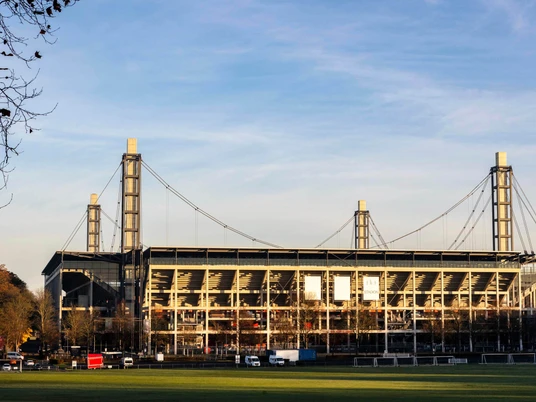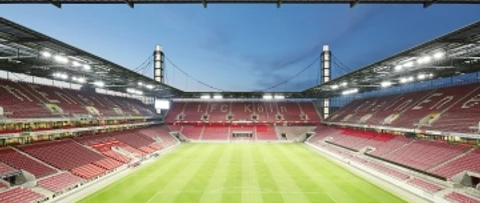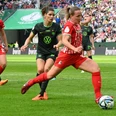- Photos & Map
How would you like to arrive?
- Call
- Details
- Useful Information
- Nearby
- Plan a visit Booking
It is often the special moments that add up to general happiness and joie de vivre. From a single moment, a deep memory takes root; from a few minutes, legendary moments grow into history. On January 31, 2004, such a moment took place in the RheinEnergieSTADION and marked the best start a new stadium could wish for: when spectators collectively shake concrete and steel for the first time. The unique FC match, in which Lukas Podolski led FC to a 1:0 victory, was the memorable christening of the stadium as a new venue.
As a mirror of the city, Cologne's RheinEnergieSTADION tells many stories today: of destruction and reconstruction, of technology and aesthetics, of love of home and the world stage as an event location. With around 50,000 seats and a 66 m² video wall, the location is ready for 50,000 sublime moments from sport to music - and also for your very own personal moment.
More such moments followed - also on a musical level, when Michael Jackson played here, Coldplay or the Rolling Stones. And: The show will go on ...
The stadium made history in the years between the world wars - with major athletics events, international matches and German gymnastics festivals. The Second World War put a heavy strain on the building, but the people of Cologne worked hard to rebuild it in the post-war period. It was not until the early 2000s that a completely new stadium was built: between 2002 and 2004, the modern stadium, which is still both an event location and the home ground of FC Köln today, was built according to plans by the architectural firm Gerkan, Marg und Partner, together with the engineers from Schlaich Bergermann und Partner.
Technically, the clear lines of sight for each row of seats and the feeling of being close to the action thanks to the steep arrangement of the tiers are worth mentioning: even from the upper rows, you have a clear and unobstructed view of the pitch.
The logistics are also well thought out: spacious aisles and short, structured routes out or to catering facilities function like an independent organism at large events.
At Christmas time, the RheinEnergieSTADION lights up into one of the largest Advent wreaths in the world: intelligent lighting technology transforms the four pylons into oversized "candles", making them glow red with yellow tips as blazing "flames".
As a mirror of the city, Cologne's RheinEnergieSTADION tells many stories today: of destruction and reconstruction, of technology and aesthetics, of love of home and the world stage as an event location. With around 50,000 seats and a 66 m² video wall, the location is ready for 50,000 sublime moments from sport to music - and also for your very own personal moment.
The kick-off: Poldi's "golden goal"
The whole story goes like this: FC hadn't won against their rivals since 1998 - the tension was high. In the 52nd minute, the then 18-year-old Lukas Podolski seized his chance: pass into the deep, quick finish, goal. With this goal, he decided the game 1:0 and gave the club a symbolic triumph - and the RheinEnergieSTADION a perfect start as a new sports venue.More such moments followed - also on a musical level, when Michael Jackson played here, Coldplay or the Rolling Stones. And: The show will go on ...
From 1923 to 2004: development into a cathedral of glass, concrete and steel
The history of today's RheinEnergieSTADION goes back a long way - to 1923, when the Müngersdorf stadium on Aachener Straße was built on the same site. Built on the initiative of the city of Cologne, it was considered one of the largest and most modern stadiums in Germany at the time.The stadium made history in the years between the world wars - with major athletics events, international matches and German gymnastics festivals. The Second World War put a heavy strain on the building, but the people of Cologne worked hard to rebuild it in the post-war period. It was not until the early 2000s that a completely new stadium was built: between 2002 and 2004, the modern stadium, which is still both an event location and the home ground of FC Köln today, was built according to plans by the architectural firm Gerkan, Marg und Partner, together with the engineers from Schlaich Bergermann und Partner.
RheinEnergieSTADION: Engineering at its best
The RheinEnergieSTADION is clear, strict and geometric: four corner towers visible from afar rise 60 meters into the sky and support a filigree cable construction that allows the 15,400 square metre roof to "float". To give you an idea: this size is roughly twice the floor area of Cologne Cathedral.Technically, the clear lines of sight for each row of seats and the feeling of being close to the action thanks to the steep arrangement of the tiers are worth mentioning: even from the upper rows, you have a clear and unobstructed view of the pitch.
The logistics are also well thought out: spacious aisles and short, structured routes out or to catering facilities function like an independent organism at large events.
Hennes: billy goat, Cologne icon, mascot
Hennes is closely associated with the stadium: billy goat, mascot and lucky charm of FC Köln. He has been at the club's side since 1950 and is now in his eighth generation. The first Hennes was a gift from circus director Carola Williams and was named in honor of the coach at the time, Hennes Weisweiler. Today, Hennes VIII lives in Cologne Zoo and attends FC home matches at the RheinEnergieSTADION - a ritual that has long since achieved cult status.Stadium tour and the largest Advent wreath in Europe
Are you curious to find out what it looks like behind the scenes of the stadium and what has already happened here: a stadium tour will give you everything you've always wanted to see and hear. Whether it's "entering the stadium through the catacombs", entering the changing rooms or listening to the anecdotes of stadium announcers and ex-professionals.At Christmas time, the RheinEnergieSTADION lights up into one of the largest Advent wreaths in the world: intelligent lighting technology transforms the four pylons into oversized "candles", making them glow red with yellow tips as blazing "flames".
Useful Information
Eligibility
for Groups
for Class
for families
for individual guests
Suitable for the Elderly
Price info
Prices vary depending on the event and ticket category. Visiting the RheinEnergieSTADION generally requires the purchase of a ticket.
Parking facilities
The walk from the RheinEnergieSTADION stop (Tram: 1) to the RheinEnergieSTADION takes about 5 minutes.
General information
Parking Available
Bus stop available
Our recommendations
Nearby


